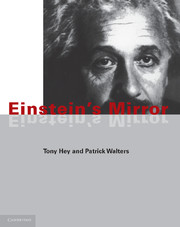Book contents
- Frontmatter
- Contents
- Preface
- 1 A revolution in time
- 2 The nature of light
- 3 Light and time
- 4 The ultimate speed
- 5 E = mc2
- 6 Matter and anti-matter
- 7 Little Boy and Fat Man: relativity in action
- 8 Down to earth
- 9 Warped space
- 10 The Big Bang, black holes unified fields
- 11 Afterword: Relativity and science fiction
- Appendix: Some mathematical details and derivations
- Chronology
- Glossay
- Quotations and sources
- Suggestions further reading
- Name index
- Subject index
- Plate section
9 - Warped space
Published online by Cambridge University Press: 05 March 2013
- Frontmatter
- Contents
- Preface
- 1 A revolution in time
- 2 The nature of light
- 3 Light and time
- 4 The ultimate speed
- 5 E = mc2
- 6 Matter and anti-matter
- 7 Little Boy and Fat Man: relativity in action
- 8 Down to earth
- 9 Warped space
- 10 The Big Bang, black holes unified fields
- 11 Afterword: Relativity and science fiction
- Appendix: Some mathematical details and derivations
- Chronology
- Glossay
- Quotations and sources
- Suggestions further reading
- Name index
- Subject index
- Plate section
Summary
No one who has really grasped it can escape the magic of this [new] theory.
Albert Einstein, quoted by A. PaisGeometry and gravity
Help me, Marcel, or I'll go crazy!
Albert Einstein, quoted by FeuerThe discovery of ‘non-Euclidean’ geometry in the nineteenth century came as a great surprise and was greeted by disbelief. One of the pioneers of this new geometry, Janos Bolyai, a Hungarian army officer, expressed his joy with the words:
I have made such wonderful discoveries that I am myself lost in astonishment. Out of nothing I have created a new and another world.
'Euclidean’ geometry is the geometry we learn in school, with its familiar apparatus of points, straight lines, circles, ellipses and triangles. In particular, we are all brought up to believe that the three angles of a triangle add up to 180 degrees and that parallel lines never meet. Such Euclidean geometry is the geometry of the plane – technically called a ‘flat’ space. By contrast, non- Euclidean geometry describes a ‘curved’ space. What do we mean by these terms?
Some idea of a curved space can be gained by considering geometry on the surface of the Earth. The Earth is approximately spherical, and on its surface it is easy to construct triangles whose angles add up to more than I 80 degrees (Figure 9. I). Similarly, lines of longitude start out parallel at the equator but converge and cross at the poles. The surface as a whole does not obey Euclid's rules. Since such a familiar example of a surface is non- Euclidean, why are such geometries so unfamiliar to most of us?
- Type
- Chapter
- Information
- Einstein's Mirror , pp. 181 - 209Publisher: Cambridge University PressPrint publication year: 1997

